Wood species
On the following pages I try to give a - really short - overview of the woods I use.
Usually all woods used come "from the neighbour's garden" and are stored and dried by me until I can use and carve them. Sometimes there are special rarities, about which I have found only insufficient information, if at all. For example rhododendron or rose root tuber.
The only wood I buy is linden, as I have not found a source in my area yet.
For some of my works I even use glued wood - I will not describe it here. It is a very interesting material. It is a very soft, long fibered wood with a beautiful grain. But see for yourself in the "My works" section.
The wood of the plum (Prunus domestica) is very hard. It is to carve very clean, but its hardness does not make it easy to carve it.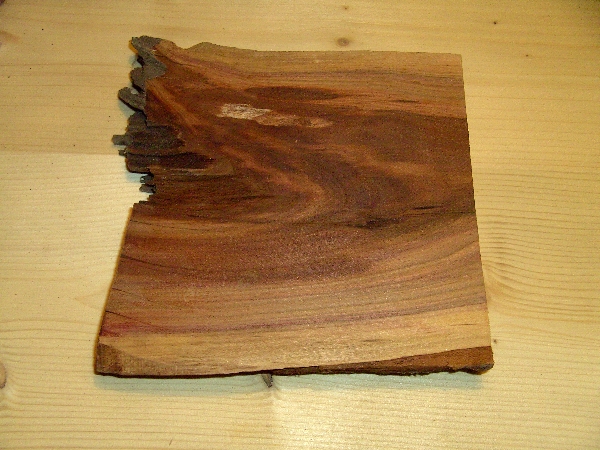
The wood is reddish brown in the core, while fresh with purple stripes, and yellow in the sapwood. The drawing is clear. The wood is hard and easy to process.
Polished and oiled, one could keep the wood thoroughly for mahogany.
.
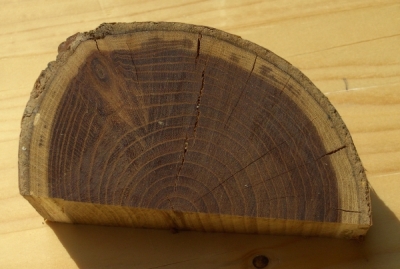
Die Japanische Blütenkirsche (Prunus serrulata), auch Orientalische Kirsche, Ostasiatische Kirsche oder Grannenkirsche genannt hat ein sehr feinporiges Holz mit einer feinen Struktur. Er wächst vor Allem in Japan und Korea, aber auch bei uns sieht man diesen Baum - vor Allem wegen seiner rosa Blütenpracht.
Splint und Kern sind klar voneinander getrennt. Das Splintholz schmal und rötlichweißgrau. Kernholz ist ein wenig dunkler und rötlichbraun mit etwas gelber Tönung. Es kann gelegentlich mit grünen Streifen durchzogen sein. Es dunkelt im Laufe der Zeit nach und wird oft zwischen Orange und Rotbraun.
Die Jahresringe sind deutlich erkennbar. Die feinen Gefäße sind im Frühholz etwas größer und sehr dichtstehend, halbringförmig angeordnet. Die Frühholzporen bilden eine auffällige, etwas dunklere Fladerung, das dunklere Spätholz bewirkt Längsstreifung. Die zahlreichen, feinen, dichtstehenden Holzstrahlen sind gut als hellglänzende Spiegel sichtbar. Gehobelte Flächen sind schwach glänzend.
Das Holz schwindet eher mäßig. Im Splint etwas stärker. Es gilt als fest und nicht sehr hart, zäh und elastisch. Beim bearbeiten verströmt es einen angenehmen Geruch.
Die Trocknung geht meist problemlos, doch das Holz wirft sich gerne. Trockenes Kirschbaumholz ist sehr gut haltbar.
Es lässt sich gut mit Messern bearbeiten und auch sonst recht gut bearbeiten. Man kann es schön polieren. Mit dem Messer geschnittene Flächen haben bereits einen leichten Glanz. Wegen seiner homogenen Struktur lässt es sich auch sehr gut polieren.
Es wird gerne für Möbel (auch als Furnier) verwendet, aber auch gerne für kunstgewerbliche Gegenstände.
Hier ein Stück Wurzelholz der Zierkirsche:
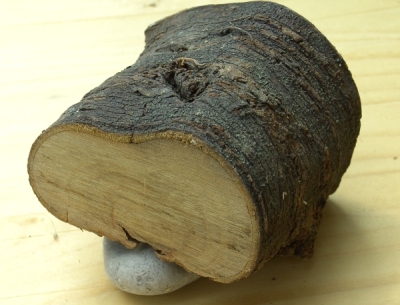
Hawthorn is distinguished in: Hawthorn, Quickthorn or Whitethorn (Crataegus monogyna orCrataegus laevigata Dc.). To distunguish the wood of these two species is difficult and is therefore described as one.
It is a very hard wood. In earlier times it was often used for tools and for carvings and was valued for its hardness, toughness and elasticity.
Today it is no longer common. Perhaps because his growth is often irregular. Sometimes it is still used for making bows.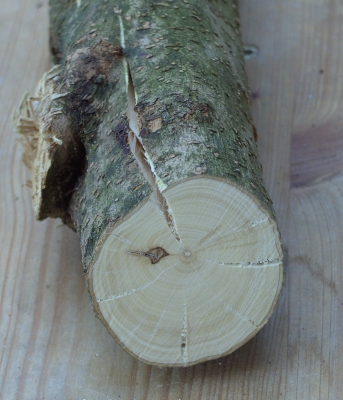 Due to the small trunk thickness you get usually only small parts of this wood.
Due to the small trunk thickness you get usually only small parts of this wood.
Previously, the wood was cut in the fall and then it has been put in the hay during the winter. In the spring you could use it, it has had a fine consistency.
The wood is tough, very hard and very weather resistant, but it is very difficult to split. It has extremely fine pores and it is smooth. After a fine finish, it feels a little matt.
It is important that the timber is sealed after processing or treatment, otherwise it tends to become dirty very easily .
It is also important to dry the wood and slowly it to seal the end grain before drying, as it greatly shrinks and tends to crack.
A particularly nice effect can be achieved apparently, if you soaked the dry wood with linseed oil. The wood then takes on shades ranging from yellow and dark honey color.
Der runzelblättriger Schneeball (Viburnum rhytidophyllum) ist eigentlich in China beheimatet in China. Etwa seit Beginn des 20. Jahrhunderts auch in Europa als Zierstrauch gepflanzt.
Das schwere, harte Holz duftet unangenehm und hat einen weißen, gelbstichigen Splint, der den gelb-rötlichen Kern umgibt. Dieser ist oft unregelmäßig gegen den Splint abgegrenzt, wobei das Splintholz sehr schmall und weißlich bis rötlich-weiß ist. Das Kernholz dagegen ist eher gelbbraun. Die Jahrringe sind nur undeutlich zu erkennen.
Der Schneeball wächst meistens strauchartig, allerdings gibt es auch kleine Bäume von bis zu 3m Höhe. Die Abmessungen des zur Verfügung stehenden Holzes sind daher eher gering
Aus den Ästen des Strauches wurden und werden Pfeile für das Bogenschießen gefertigt, die wegen des fasrigen Aufbaus sehr elastisch und bruchfest sind. Daher auch sein englischer Name "arrow wood". Meist nutzen Bogenschützen des traditionellen Bogenschießens mit Langbogen Pfeile aus diesem Holz.
The Horse chestnut (Aesculus hippocastanum) is also called common chestnut or white chestnut. It is relatively fast growing and growth up to 30 meters. it is about 300-400 years old.
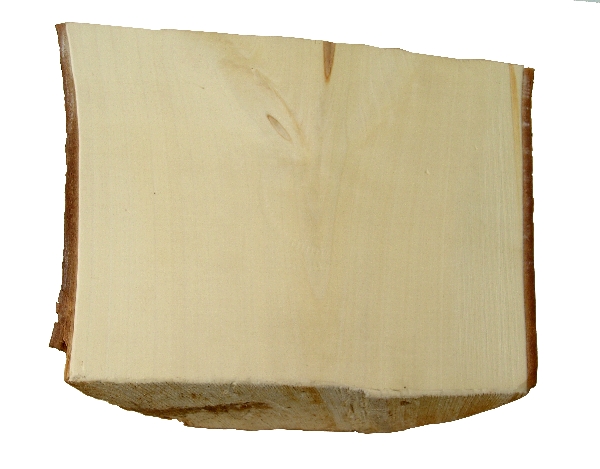 The wood of the horse chestnut is medium hard and medium heavy. The wood of the trunk is rather simple and very bright.. It can be used for woodturning very well.
The wood of the horse chestnut is medium hard and medium heavy. The wood of the trunk is rather simple and very bright.. It can be used for woodturning very well.
The chestnut is a sapwood tree, that means that sap wood and heart wood do not differ. The wood has a light brownish or yellowish white color. It has only a very light grain and has a rather plan wood.
Most of the trees are cross-grained, but always to the right! it shrinks very little and has a quite good stability. The burl woodhas a special beauty.
Page 1 of 6



